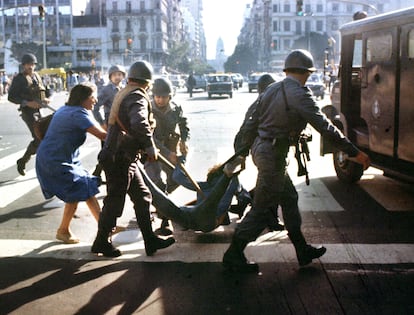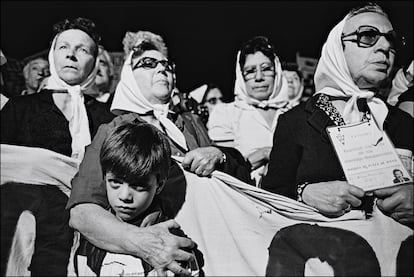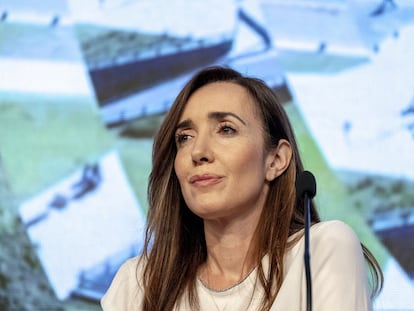After 45 years, Argentina brings those who covered up the dictatorship’s death flights to trial
A judge, a doctor, police officers and officials are accused of having hidden the bodies that arrived on the beaches of Buenos Aires after being thrown from military planes

In December 1978, strong south-easterly winds dragged a dozen corpses from the sea to various beaches in Argentina. They were naked and showed signs of having suffered a violent death. But none of these cases led to a judicial investigation; instead, they were secretly transported to nearby cemeteries and buried as “NN” (unidentified persons). Police, judges, and municipal officials acted in a coordinated manner to prevent it from coming to light that they were victims of the death flights with which the dictatorship disposed of the bodies of people it had kidnapped. Over 45 years later, the Argentine justice system has for the first time brought to trial the alleged perpetrators of this cover-up network.
“The bodies were found scattered along a coastal strip some 150 kilometres long,” says Daniel Iglesias, the author of an investigation that provided the first clues to clarify what happened. Iglesias found more than 20 files concerning bodies returned by the sea between 1977 and 1978 that had been buried without identification. “In none of the cases were police sent to see if a relative could be found, or were the press was called, or anything possible done to identify the body. The judge did nothing, when it was his responsibility,” adds Iglesias from Villa Gesell, one of the towns where victims of the death flights washed up.
The defendants in the case are the investigating judge in the town of Dolores at the time, Carlos Facio; the police doctor Miguel Cabral, who is accused of having concealed the fact that they were victims of violent death in four files; seven former agents of the Buenos Aires police, and municipal officials. After a preliminary hearing last week, the first witnesses will testify Thursday and the rest at the beginning of next year, in a trial that will take place in the city of Mar del Plata.
The plaintiff’s lawyer, Pablo Llonto, highlights the importance of a trial that seeks to shed light on the last stage of the systematic plan of extermination implemented by the dictatorship that ruled Argentina between 1976 and 1983. The courts have convicted over 1,000 people, mostly military personnel, for crimes against humanity committed during that period. The military regime opened hundreds of clandestine detention centres throughout the country, and in Buenos Aires and its surroundings one of the most common methods for getting rid of kidnapped people was to put them on planes and throw them, drugged and tied up, into the Río de la Plata or the Atlantic Ocean.

Due to a miscalculation regarding the winds and tides, a handful of these bodies did not end up on the seabed but washed ashore. The courts must now determine the alleged responsibility of the accused in hiding them. “They hid them knowing that they came from the death flights,” Llonto stated.
One of the bodies that remained unidentified for three decades was that of Santiago Villanueva, a member of the Juventud Peronista group, who was kidnapped on July 26, 1978. His eldest son, Guillermo, was 12 years old at the time. “I spent my whole life looking for him and I never thought we would find him,” he says, recalling a disappearance that marked the life of his entire family.
Now 57, Guillermo Villanueva is preparing to testify before a judge for the third time in his life. He still remembers with some disbelief the moment when the Argentine Forensic Anthropology Team announced to him that they had identified his father’s remains. The DNA of the remains exhumed from the Villa Gesell cemetery matched that of his uncle Ernesto Villanueva, the brother of the missing man. The forensic anthropologists knew where to dig thanks to a notebook from the cemetery in which they wrote down by hand where each dead person was buried. Santiago Villanueva was listed as “Saladito NN.” “They called the bodies that came from the sea ‘saladitos,’” says Guillermo.
The identification was made in 2005 and in 2006 the remains were returned to him, which today rest in the Chacarita cemetery, the largest in Buenos Aires. “He was whole, except for his hands. It was shocking to have the opportunity to see him for the last time,” recalls Guillermo. “I was with him for 15 minutes after 30 years, and then the story began to change: from a missing person to a found person. I understood why I had fought for so many years to keep the memory alive and how finding him would restore dignity to my family,” he continues. His goal now is to see justice done, although what he would most like is for his companions to also recover the remains of their relatives, who are still missing. “There are very few of us who were lucky enough to find them,” he concludes.

Sign up for our weekly newsletter to get more English-language news coverage from EL PAÍS USA Edition
Tu suscripción se está usando en otro dispositivo
¿Quieres añadir otro usuario a tu suscripción?
Si continúas leyendo en este dispositivo, no se podrá leer en el otro.
FlechaTu suscripción se está usando en otro dispositivo y solo puedes acceder a EL PAÍS desde un dispositivo a la vez.
Si quieres compartir tu cuenta, cambia tu suscripción a la modalidad Premium, así podrás añadir otro usuario. Cada uno accederá con su propia cuenta de email, lo que os permitirá personalizar vuestra experiencia en EL PAÍS.
¿Tienes una suscripción de empresa? Accede aquí para contratar más cuentas.
En el caso de no saber quién está usando tu cuenta, te recomendamos cambiar tu contraseña aquí.
Si decides continuar compartiendo tu cuenta, este mensaje se mostrará en tu dispositivo y en el de la otra persona que está usando tu cuenta de forma indefinida, afectando a tu experiencia de lectura. Puedes consultar aquí los términos y condiciones de la suscripción digital.
More information
Archived In
Últimas noticias
Most viewed
- Sinaloa Cartel war is taking its toll on Los Chapitos
- Oona Chaplin: ‘I told James Cameron that I was living in a treehouse and starting a permaculture project with a friend’
- Reinhard Genzel, Nobel laureate in physics: ‘One-minute videos will never give you the truth’
- Why the price of coffee has skyrocketed: from Brazilian plantations to specialty coffee houses
- Silver prices are going crazy: This is what’s fueling the rally










































